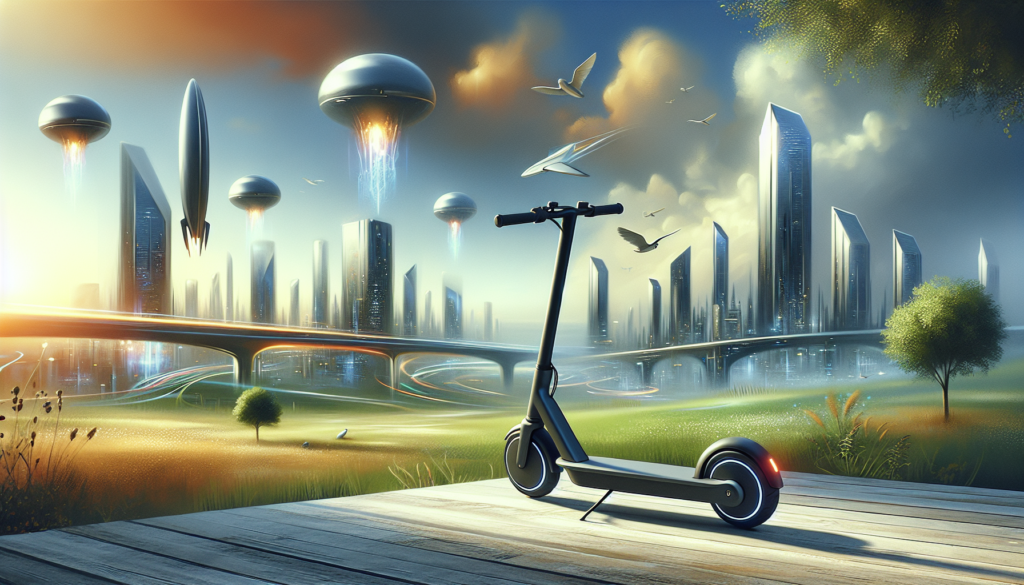
As cities around the world evolve, so does the way we navigate them. In Malaysia, the rise of escooters is transforming urban travel, offering a convenient and eco-friendly alternative for commuters. With their nimble design and ease of use, escooters are not just a trend but a glimpse into the future of personal mobility. As we delve deeper into how these electric rides are reshaping the landscape of our cities, we will explore their benefits, challenges, and the implications for urban infrastructure and policy.
The Rise of Escooters in Malaysia
In recent years, Malaysia has witnessed a significant surge in the popularity of escooters, transforming the landscape of urban mobility. With the growing concerns over traffic congestion and the quest for more sustainable travel solutions, many Malaysians are turning to escooters as an efficient mode of transport. Cities like Kuala Lumpur have become hotspots for escooter rentals, providing residents and tourists with a convenient alternative to traditional vehicles. The introduction of dedicated escooter lanes and supportive infrastructure further accelerates this trend, showcasing the government’s commitment to promoting eco-friendly transportation options.
As the adoption of escooters continues to rise, various local startups and international companies are expanding their services throughout Malaysia. This proliferation is not only helping to address the challenges of urban congestion but also contributing to a greener environment by reducing carbon emissions. Moreover, escooters cater to diverse demographics, from students commuting to campus to professionals seeking quick trips across the city. The convenience, affordability, and ease of use make escooters an attractive choice for many urban dwellers, signaling a promising future for personal mobility in Malaysia.
Benefits of Escooters for Urban Commuters

Escooters are revolutionizing urban travel in Malaysia by providing numerous benefits to commuters. One of the most significant advantages is their convenience; escooters are a time-efficient mode of transportation for short to medium distances, allowing users to navigate through traffic congestion effortlessly. With the rise of urban areas and the increasing population density, escooters offer a practical solution that reduces the time spent in transit. Furthermore, they are easy to park, minimizing the hassle of finding car parking spaces in busy city centers, which further enhances their appeal to urban dwellers seeking quick and efficient travel options.
In addition to convenience, escooters promote a greener environment. They are an eco-friendly alternative to traditional gasoline-powered vehicles, reducing carbon emissions and contributing to cleaner city air. This aligns with Malaysia’s sustainability goals and urban development plans. As more commuters shift to escooters, cities can expect a decrease in noise pollution and traffic-related problems. Embracing escooters not only makes urban commuting more viable but also supports broader efforts to create smarter, more sustainable urban environments in Malaysia, ensuring a better quality of life for its citizens.
Escooter Infrastructure and Development in Malaysian Cities

The growth of escooter infrastructure in Malaysian cities is transforming urban travel, offering an eco-friendly alternative to traditional modes of transport. As more cities embrace sustainable mobility, the implementation of dedicated escooter lanes, charging stations, and parking facilities becomes essential. Local governments are increasingly investing in infrastructure that can accommodate these electric two-wheelers, providing a safer and more efficient way for citizens to navigate their urban environments. This initiative is not only aimed at reducing traffic congestion but also at promoting greener travel options that are less reliant on fossil fuels.
In tandem with the infrastructure development, several Malaysian cities are launching pilot programs and partnerships with private e-scooter companies to enhance accessibility and user experience. By integrating e-scooters into existing public transport networks, city planners are aiming to create a seamless travel experience that encourages more residents to adopt this sustainable mode of transport. Additionally, public awareness campaigns and regulations are being implemented to educate users about safe riding practices, ensuring that e-scooters can coexist alongside other vehicles on the streets. This holistic approach paves the way for e-scooters to effectively shape the future of urban mobility in Malaysia.
Challenges Facing Escooter Adoption
Despite the growing popularity of escooters in Malaysia, several challenges hinder their widespread adoption. One major concern is the lack of adequate infrastructure to support escooter usage, including designated lanes and safe parking facilities. Urban areas often struggle with traffic congestion, and integrating escooters into the existing transportation framework can lead to potential hazards for both riders and pedestrians. Additionally, regulatory challenges arise as local governments grapple with creating effective policies that manage escooter operations while ensuring public safety. Without clear guidelines and infrastructure enhancements, potential riders may hesitate to adopt this innovative mode of transport.
Moreover, the perception of safety among users plays a crucial role in e-scooter adoption. Many individuals remain apprehensive about riding an e-scooter due to the risks associated with accidents and injuries. Educating the public on safe riding practices and the benefits of e-scooters can help alleviate these concerns. Companies operating e-scooters in Malaysia also face the challenge of maintaining their fleets and ensuring that the vehicles are in good condition. Addressing these challenges through improved infrastructure, regulatory clarity, and community engagement can pave the way for a smoother transition towards e-scooters as a viable mode of urban travel in Malaysia.
Safety and Regulations for Escooter Riders
As escooters continue to gain popularity in urban areas of Malaysia, ensuring the safety of riders and pedestrians becomes paramount. With the increase in usage, the Malaysian government has been actively working on establishing comprehensive regulations that address safety concerns. This includes requirements such as mandatory helmet use, age restrictions for riders, and designated lanes for escooter operation. These regulations are designed to mitigate risks associated with escooter travel, helping to create a safer environment for everyone on the road. This proactive approach promotes responsible riding behaviors and strengthens the overall perception of escooters as a viable mode of transportation.
Moreover, public awareness campaigns are essential in educating both riders and pedestrians about safe interactions in urban settings. Riders are encouraged to familiarize themselves with traffic rules, be vigilant about their surroundings, and maintain their e-scooters to ensure optimal performance. Local authorities can also foster better understanding by collaborating with e-scooter sharing companies to implement training programs for users. By prioritizing safety and adhering to regulations, Malaysia can embrace the full potential of e-scooters while minimizing hazards, ultimately paving the way for smoother urban travel in the future.
The Environmental Impact of Escooters

Escooters are emerging as a pivotal solution to urban travel challenges in Malaysia, particularly in addressing environmental concerns. Traditional modes of transportation contribute significantly to air pollution and greenhouse gas emissions, exacerbating climate change. In contrast, escooters are electric vehicles that produce zero tailpipe emissions, providing a cleaner alternative for short-distance travel while reducing the carbon footprint of urban commuters. With cities like Kuala Lumpur grappling with traffic congestion and its adverse environmental effects, the adoption of escooters promotes cleaner air and a more sustainable urban landscape.
Moreover, e-scooters contribute to reduced noise pollution, enhancing the urban environment’s livability. They offer an efficient mode of transport, encouraging more people to leave their cars behind, thus decreasing the vehicular traffic that contributes to environmental degradation. As cities evolve and prioritize eco-friendly solutions, the integration of e-scooters into the urban transportation system represents a significant leap towards greener mobility. Supporting local initiatives and infrastructure that facilitate e-scooter use can further enhance their positive impact on Malaysia’s urban ecosystems, paving the way for a cleaner and healthier future for its citizens.
The Future of Escooter Technology
The future of escooter technology in Malaysia is poised to revolutionize personal mobility in urban areas. With rapid advancements in battery technology, we can expect lighter, more efficient, and longer-lasting scooters that enhance the overall user experience. Manufacturers are now focusing on integrating smart technologies, such as GPS tracking and app-based management systems, allowing riders to monitor their trips, check battery levels, and even locate available scooters nearby. This level of connectivity not only improves convenience but also increases safety for users navigating busy city streets.
Additionally, innovations in e-scooter design are likely to lead to more eco-friendly options. As cities in Malaysia push for sustainable transport solutions, manufacturers are committed to developing scooters that utilize recycled materials and low-impact manufacturing processes. The integration of solar charging capabilities could further enhance the sustainability of e-scooters, making them a staple in urban mobility. With a strong emphasis on minimizing carbon footprints and reducing traffic congestion, e-scooters will undoubtedly play a crucial role in shaping the future landscape of Malaysia’s transportation system, ultimately transforming how residents navigate their cities.
Comparing Escooters to Other Modes of Urban Transport
When examining the landscape of urban transportation in Malaysia, escooters emerge as a competitive alternative to traditional modes of transport such as cars, buses, and bicycles. Unlike cars, which contribute significantly to traffic congestion and pollution, escooters offer a compact and eco-friendly option for short-distance travel. Furthermore, they require less parking space, alleviating some of the burden on urban infrastructure. Buses, while efficient in moving larger groups, may suffer from delays and incomplete routes, making them less flexible compared to the on-demand convenience of escooters.
Meanwhile, bicycles require physical exertion, which might not be suitable for all commuters, especially in Malaysia’s humid climate. The overall efficiency of e-scooters in blending accessibility with environmental considerations positions them favorably in the realm of urban transport. On the other hand, the uptake of e-scooters is not without its challenges. Issues such as safety, regulation, and the integration of e-scooters into existing transport systems present potential hurdles. As cities evolve to accommodate these new modes of transport, it’s crucial to establish safety protocols and clear riding pathways to protect users and pedestrians alike.
Moreover, urban planners must consider how e-scooters can complement public transport systems, ensuring a seamless end-to-end travel experience. By tackling these challenges, e-scooters can define a new paradigm in urban mobility, making travel in Malaysia not just easier but also more sustainable.
Embracing the Escooter Revolution
As we move towards a more sustainable future, escooters are increasingly becoming a pivotal solution to the challenges of urban travel in Malaysia. They provide not only an efficient means to navigate through congested streets but also help reduce carbon footprints, aligning with the nation’s ambition towards greener transportation. The rise of escooters is indicative of a broader trend where personal mobility is becoming more versatile and user-friendly, making them an attractive option for commuters across the country. As urban planners continue to integrate these electric vehicles into the public transport system, we can expect a significant transformation in how Malaysians perceive and utilize public mobility.
This urban revolution is just beginning, and the potential for e-scooters to reshape our cities is immense. By promoting safety regulations, infrastructure adaptations, and public awareness campaigns, Malaysia can ensure that the future of personal mobility remains not only exciting but also safe and accessible for all. Embracing this transition with EKO Life MY will be essential for fostering a sustainable urban environment that supports diverse transportation needs. As we prepare to navigate tomorrow, let’s welcome e-scooters as a vital component of Malaysia’s evolving travel landscape.

Not enough insights, hope the next part provides more
Hi Jayden Khiang, thank you for sharing your thoughts on the blog post. We appreciate your feedback and are glad to hear that you’re looking forward to the next part. We’ve taken note of your request for more insights and will do our best to provide a more in-depth analysis in the future. If you have any specific questions or topics you’d like to see covered, please don’t hesitate to reach out to us at [email protected] or +60 3-7890 3042. We’re always here to help.
Interesting, but more background would help
Thank you for your comment, Zara Tan! We appreciate your feedback and understand that more background information can be helpful in fully understanding our products and services. We’d be more than happy to provide additional context and information. If you would like, please feel free to reach out to us at [email protected] or call us at +60 3-7890 3042 so we can discuss further. We’re here to help and would love to empower you to experience the best in bicycle, ebike, and escooter community!
I was expecting more concrete data and analysis
Dear Caitlin Rajoo, thank you for sharing your thoughts with us. We understand that you were expecting more concrete data and analysis in our blog post. We appreciate your feedback and would like to invite you to share more about what you were expecting. This will help us to better understand your needs and preferences. If you’re looking for more in-depth information, please feel free to reach out to us at [email protected] or call us at +60 3-7890 3042. We’re here to help. Best regards, Eko Life Malaysia.